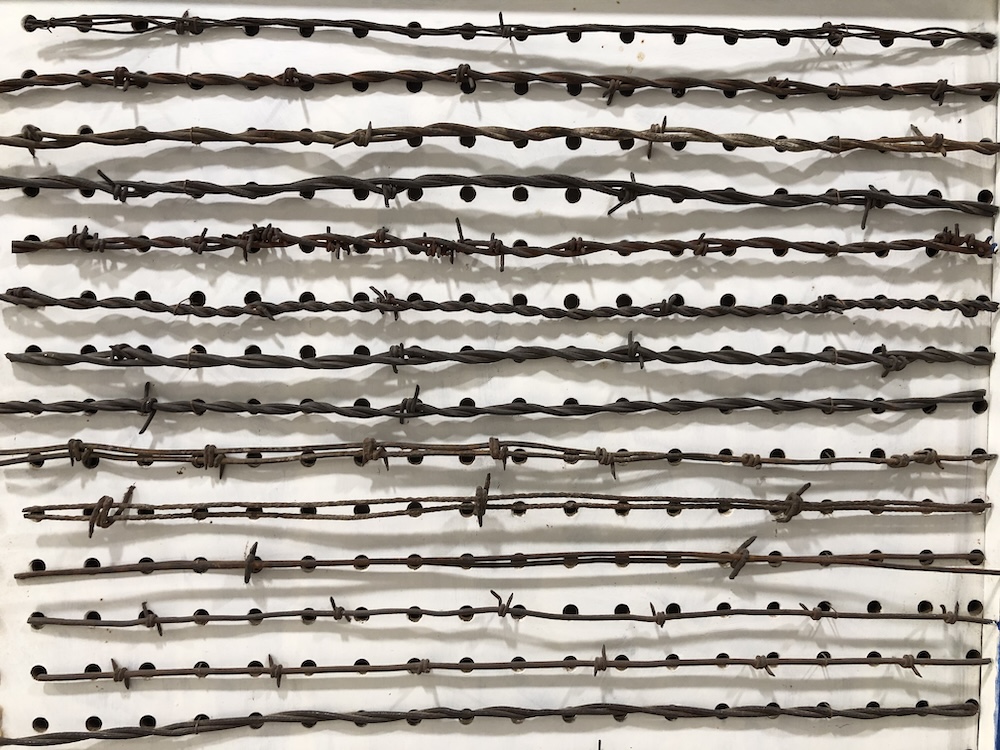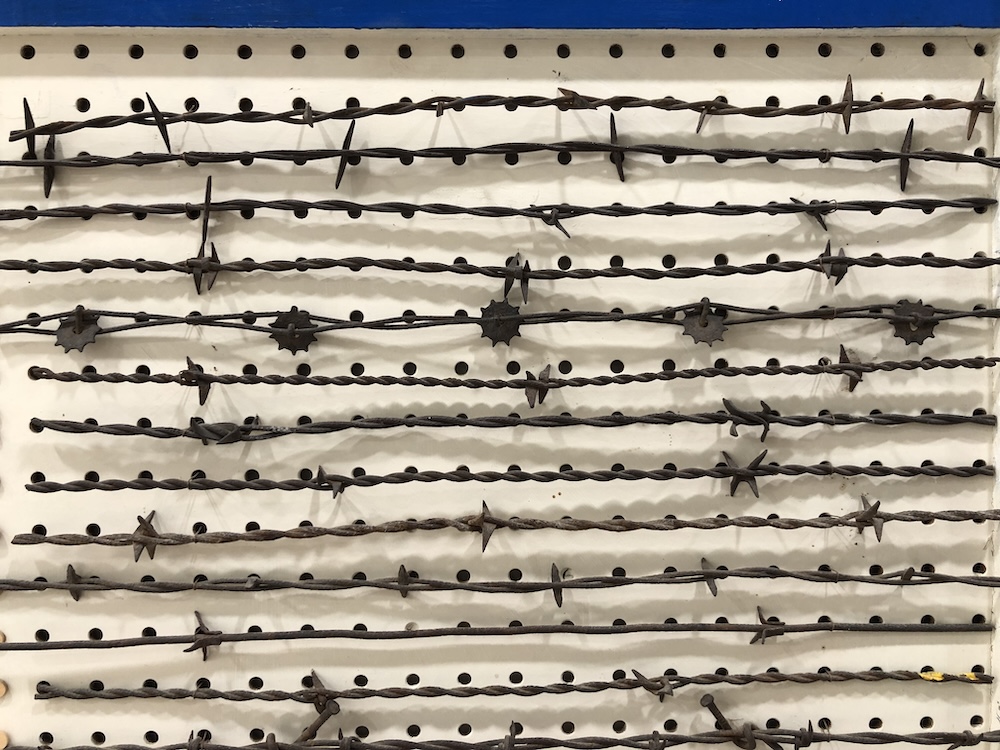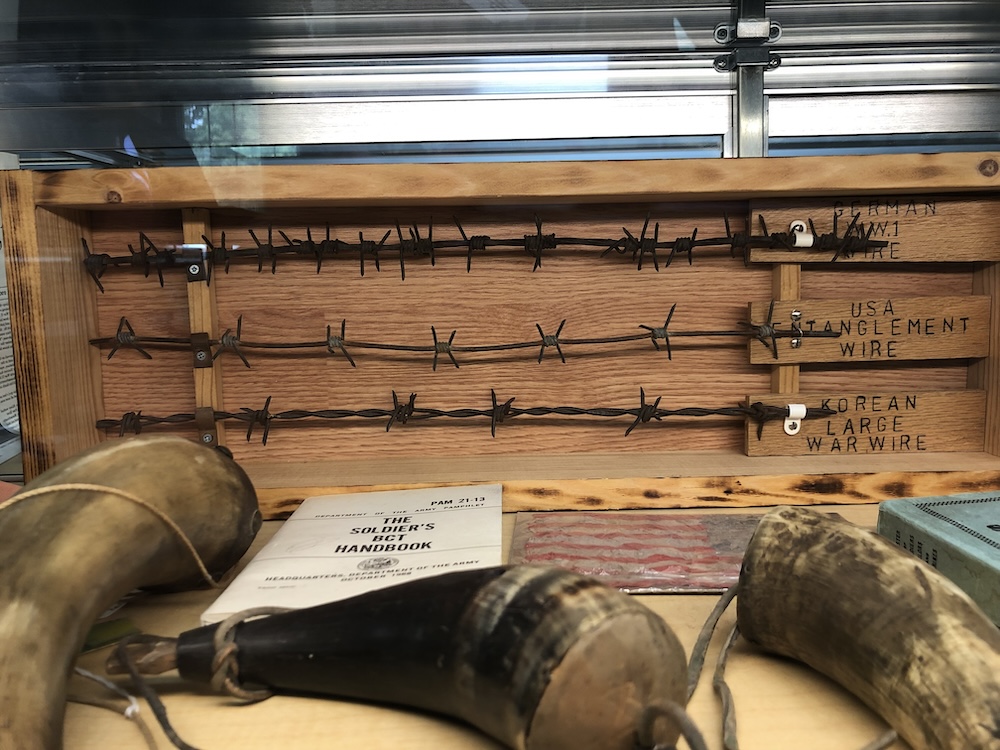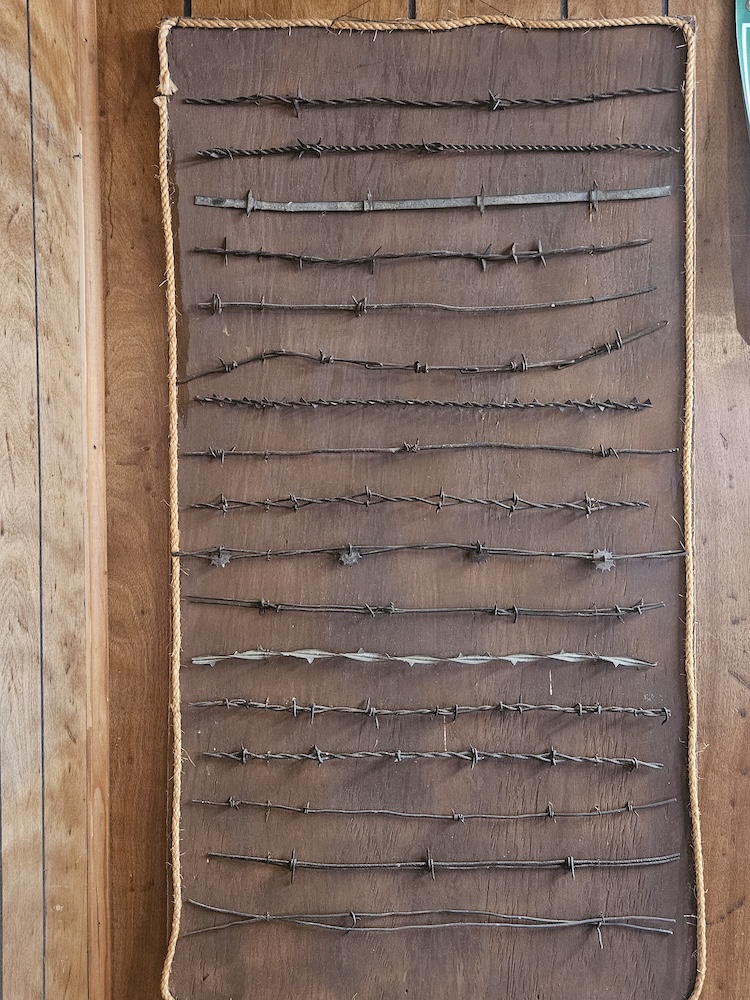The semiotics of barbed wire fence
« previous post | next post »
A week ago, I was in Gothenberg, Nebraska and went to the local historical museum. I asked the volunteers there what was the most unusual, interesting, and important exhibit they had. One of them, Barbara Fisher, thought for a moment, then said, "We have a unique collection of barbed wire fence downstairs, each strand of which is specific to the ranch or tract where it was used." She must have read my mind and heart, for that is just the sort of thing that would captivate me.
So I dashed down the stairs and beheld:
That incredible collection of barbed wire fences — each one different (I'll describe that in more detail below) — was put together by Roy Farnstrom, a retired electrician.
Here's one panel of the collection:
And here are some closeups:
From the way the barbs were wrapped around and woven through the horizontal strands, the ranchers could tell at a glance if the land and animals enclosed within belonged to them — I call them "signature barbs" — sort of like a premodern QR code.
When people started settling the Great Plains, there was nothing out here but millions of buffalo and some scattered Indians. There were no land divisions, no fences, no houses, no roads, no towns…. Moreover, since the land was so inhospitable, most people were intent on going further westward — even to the coast.
The first barbed wire was invented in 1867 by Lucien B. Smith of Kent, Ohio, which is 32 miles from my home in Osnaburg, Ohio. That changed everything. Wooden fences were vastly more expensive (there were very few trees out here then), difficult to install, and hard to maintain — plus they weren't as effective as barbed wire. So the barbed wire fences started to impose some order on the Great Plains.
After studying the Farnstrom collection for several hours, I went back upstairs and was surprised to find this:
The first row is German barbed wire from WW I, the second is US "entanglement wire", and the third is Korean "large war wire".
A hundred miles to the west, at Crusty's Feed Store in Arthur, I was delighted to find this collection of barbed wire fence with signature barbs:
It was assembled by Barbara Jean Hartman. According to the naming practices of the area, she had several nicknames: Bobbie, Bobbie Jean, and Cookie. The last one derives from her serving as cook on the chuckwagon when the ranchers and cowboys went out to brand their cattle or engage in other group efforts.
There are other ways that ranchers signal their ownership of animals, the most colorful of which is branding, a practice that goes all the way back to ancient Egypt. Here in the sandhills of western Nebraska, the members of the community will come together and brand one rancher's recently born cattle on a Saturday morning, then have a meal together, somewhat like an Amish barn raising.
Branding reminds me of the tamgas of Central Asian peoples:
A tamga or tamgha (from Old Turkic: , romanized: tamga, lit. 'stamp, seal'; Turkish: damga; Mongolian: tamga; Adyghe: тамыгъэ, romanized: tamığə; Kabardian: дамыгъэ, romanized: damığə) was an abstract seal or stamp used by Eurasian nomads and by cultures influenced by them. The tamga was normally the emblem of a particular tribe, clan or family. They were common among the Eurasian nomads throughout Classical Antiquity and the Middle Ages. As clan and family identifiers, the collection and systematic comparison of tamgas is regarded to provide insights into relations between families, individuals and ethnic groups in the steppe territory.
Still to come in this series on communication in the Great Plains, I will write on the Pony Express, the transcontinental railroad, and the telegraph, plus how and when they shaped our nation, not to mention how Gothenberg — in the heart of Nebraska — came to be called by that Scandinavian name.
Selected readings
- "The Fall Eggcorn Crop" (11/26/04) — "bobwire," etc.
- "Fecal compounds" (3/5/16) — "barbed wire canoe"
[Thanks to Nancy Fisher and Bryan Walker]






AntC said,
June 22, 2024 @ 10:03 pm
Early New Zealand settlers faced with the same difficulty (most of the timber was cut for housing) introduced gorse hedges from the old country. What you might call natural barbed wire.
But unlike back in Scotland, here gorse has no natural predators, spreads all over what should be grazing land, so has become a huge pest.
tudza said,
June 23, 2024 @ 3:13 am
How about barbwire used for transmitting telephone calls?
David Charlton said,
June 23, 2024 @ 7:04 am
It's possibly too late for your itinerary but about 200 miles east of Gothenburg you will find Beatrice and its Homestead Museum. In it you will find a very informative description of the life of these early settlers including barbed wire samples. Among the exhibits, you will find an assertion that the most important technology for settling the Great Plains was the bicycle. It allowed for lost cost mobility badly needed by the settlers. Full disclosure, I last visited there 8 years ago. It may be different now. Well worth the stop although Beatrice is pretty small!
Victor Mair said,
June 23, 2024 @ 8:57 am
@David Charlton
Thank you very much for calling the Beatrice Homestead Museum to my attention. Since I religiously follow Route 30 / Lincoln Highway, it's no wonder that I missed it, because Beatrice is about a hundred miles south on Route 136.
I'm very interested in the museum's "assertion that the most important technology for settling the Great Plains was the bicycle". In the dozens of small towns strung along Route 30 for hundreds of miles across the state of Nebraska, I haven't seen a single mention or evidence of the bicycle as being important for the settling of the Great Plains during the 1860s and 1870s when it all began and which is the period I focus on. I suspect that the Beatrice Homestead Museum is talking about a period later than that when the recently invented power pedaled bicycle became more widespread.
bks said,
June 23, 2024 @ 9:39 am
Bicycles are the technology missing from the current spate of post-apocalyptic drama. Gasoline deteriorates quickly (months).
Chris Button said,
June 23, 2024 @ 9:57 am
Truly fascinating. I had no idea. It makes me think of the distinctive patterns in textiles that distinguish affiliations.
Philip Taylor said,
June 23, 2024 @ 10:34 am
Victor, may I ask what you mean by a "power pedaled bicycle" ? The phrase appears unattested as far as Google is concerned, and as a road cyclist (Litage / Suntour / Sakae-Ringyo) it is not clear to me with what you are contrasting it.
Jarek Weckwerth said,
June 23, 2024 @ 10:58 am
This is all very interesting, but who on earth manufactured all those variations? Did each farm make its own barbed wire?
Victor Mair said,
June 23, 2024 @ 11:16 am
@Philip Taylor
I found the expression somewhere on the internet in a discussion of the history of bicycles. It signifies bicycles that have peddles which are pushed to power the bicycle forward, unlike earlier bicycles that the rider propelled by pushing his feet on the ground.
Philip Taylor said,
June 23, 2024 @ 11:26 am
Ah, fair enough. I suppose that I would have written "pedal-powered bicycle" rather than "power pedaled bicycle" because the latter initially suggested to that there was an auxiliary power source in addition to the pedals …
Victor Mair said,
June 23, 2024 @ 1:12 pm
I think you're right, Philip.
maidhc said,
June 23, 2024 @ 3:46 pm
The early bicycles with pedals had the pedals directly connected to the wheel, like a child's tricycle. The wheel had to be very large to get the proper ratio of pedal power to speed. This was the "penny-farthing" bicycle. It was also called a "wheel", as in Jack London stories. Hence the League of American Wheelmen, now known as the League of American Bicyclists.
The next big innovation was the chain drive, in the late 1880s, which moved the gear ratio to the two gear wheels, allowing the road wheels to be equal sizes. This was the "safety bicycle", more or less the same as the modern bicycle. This was a big social innovation, for it was seen as appropriate for women, since it could be ridden wearing a skirt. For the first time women could get away from home under their own power.
I don't know how well bicycles would do after the apocalypse, because they are dependent on the vulcanization of rubber to manufacture the tires. This process, invented by Charles Goodyear, was important to the development of the bicycle, among other things. But also, building the frame requires the availability of metal tubing. Really the bicycle is the product of an industrial society. So "A Connecticut Yankee in King Arthur's Court" is just a fantasy.
The existence of so many different types of barbed wire seems to imply that it could be produced by a relatively small factory. Perhaps the basic wire was produced in bulk, and small local outfits added their own barbs?
Philip Taylor said,
June 23, 2024 @ 4:11 pm
In Britain at least, the penny-farthing was also known as an "ordinary". I imagine (but have not checked) that it was given the name of "ordinary" only after more refined versions were produced.
David Charlton said,
June 23, 2024 @ 5:08 pm
@Victor Mair I think you are probably right about the period assigned to the bicycle's contribution to the development of the Great Plains. Based on my dim recollection of the exhibit, it featured an old bike, a painting of a sod dugout in the evening with bicycle leaning against the hitching post out front, and a descriptive panel next to the painting. It asserted in the period between advanced settlement of the GP and the wider adoption of the automobile, the bicycle played a key role in development. On a bike, a workman could roam much farther than on foot in search of part time or full-time employment or for markets for buying or selling goods. Moreover, a bike was much cheaper than owning horses, which had higher value uses in any case. The curator (I assume) maintained that the bike helped farm laborers become skilled workers since they could deploy their skills or labor in towns they could not reach on foot. It seemed plausible to me at the time. I am not well read on that matter. I did find the museum's treatment of the homesteaders very engaging and informative, worth the diversion.
Victor Mair said,
June 23, 2024 @ 6:07 pm
Judging from what the local people told me, most small towns had someone who was skilled at making custom barbed wire from basic wire bought in bulk.
In general, I was highly impressed by how resourceful the ranchers are still today, even more so in the old days. With low population density in small towns and villages spread out across the land at considerable distances (average around 20 miles or more), the settlers learned to do things for themselves.
Seth said,
June 23, 2024 @ 9:18 pm
@maidhc I believe the idea is that, just a few years after the apocalypse, all the gasoline-based vehicles will be useless, as gasoline cannot be stored too long. However, the pre-apocalypse bicycles will still be functional, as the parts in them don't degrade nearly as fast. Making new bicycles might not be possible. But the existing frames should last a very long time. Improvising tires strikes me as easier than making gasoline, though I must admit I'd have no idea how to do it.
AntC said,
June 24, 2024 @ 12:32 am
Quick! Stock up on airless bicycle tyres. Much less vulnerable to punctures.
(Having ridden one, I'd say you'd rapidly become half-man, half bicycle. Or perhaps I mean the bicycle would become half-human, as recounted in 'The Third Policeman' [Flann O'Brien]; due to the atomic theory.)
I presume the apocalypse would render all roads at least as bumpy as the country lane I had to negotiate.
Peter Taylor said,
June 24, 2024 @ 5:46 am
I have seen wooden bicycles both in an exhibition of Leonardo de Vinci's inventions (or, in some cases, possibly supposed inventions) and on "maker" YouTube channels.
KeithB said,
June 24, 2024 @ 8:33 am
Bikes – especially mountain bikes maybe practical post apocalypse, but not as cool as a Pursuit Special – last of the V-8 Interceptors with the supercharger poking up out of the hood.
Benjamin E. Orsatti said,
June 24, 2024 @ 8:59 am
Hmm…
EricS said,
June 26, 2024 @ 3:09 pm
DeKalb, Illinois was an important center for barbed wire in the late 1800s. Northern Illinois University was developed on property donated by Joseph F. Glidden, who owned a patent on a popular barbed wire design.
https://northernstar.info/83917/lifestyle/how-invention-of-barbed-wire-in-dekalb-established-niu/
mcur said,
June 26, 2024 @ 4:31 pm
> Korean "large war wire"
I suppose this is wire for the "large war" as in 大戦/대전, referring presumably to the Second World War, rather than large wire for war, but I'm not sure. Is anyone more knowledgeable in Korean able to speculate?
Rodger C said,
June 30, 2024 @ 9:59 am
mcur, I suppose that "large war-wire" might mean wire large enough to hinder determined humans. It does look large in the picture.